Trek Slash+
Wheel Size: 29’’ front / 27.5” rear (27.5’’ front and rear on size Small)
Travel: 170 mm rear / 170 mm front
Geometry highlights:
- Sizes offered: S, M, L, XL
- Headtube angle: 63.4° (Neutral headset position)
- Reach: 479 mm (size Large, neutral headset position)
- Chainstay length: 434 mm (size Large, neutral headset position)
Frame material: Carbon fiber
Price: Complete bikes starting at $7,999.99 USD / $10,999.99 CAD
Blister’s Measured Weight 45.8 lb / 20.8 kg (Slash+ 9.9, Size Large)
Reviewer: 6’, 165 lbs / 183 cm, 74.8 kg
Test Locations: Washington
Test Duration: 3 months
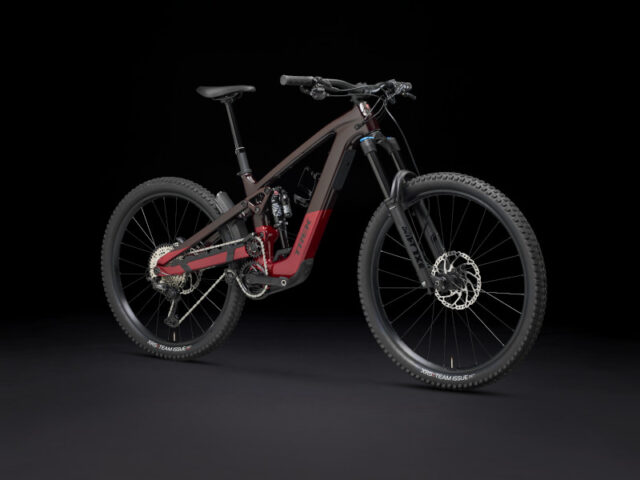
Intro
The non-electric Trek Slash was Trek’s first high pivot bike beyond the Downhill-focused Session, but it impressed us with its composure in rough terrain balanced with better-than-expected pedaling performance from such a burly bike. Clearly Trek agreed that they were onto something special with the Slash, as the Slash+ takes the same 170 mm travel and nearly identical geometry, but integrates a lightweight TQ HPR50 motor and larger than average (for a lightweight eMTB) 580 Wh battery.
Despite that development story sounding simple, Trek gave us a deep dive into the concept phase of the Slash+, including the story behind some wild looking aluminum test mules with batteries strapped to the outside, as they took a ground-up approach to deciding on motor configuration, battery size, and frame design. The Slash+ is the fruit of that labor, and it has some impressive details that should make for a uniquely composed, descent-oriented eMTB offering. Let’s dive into the details.
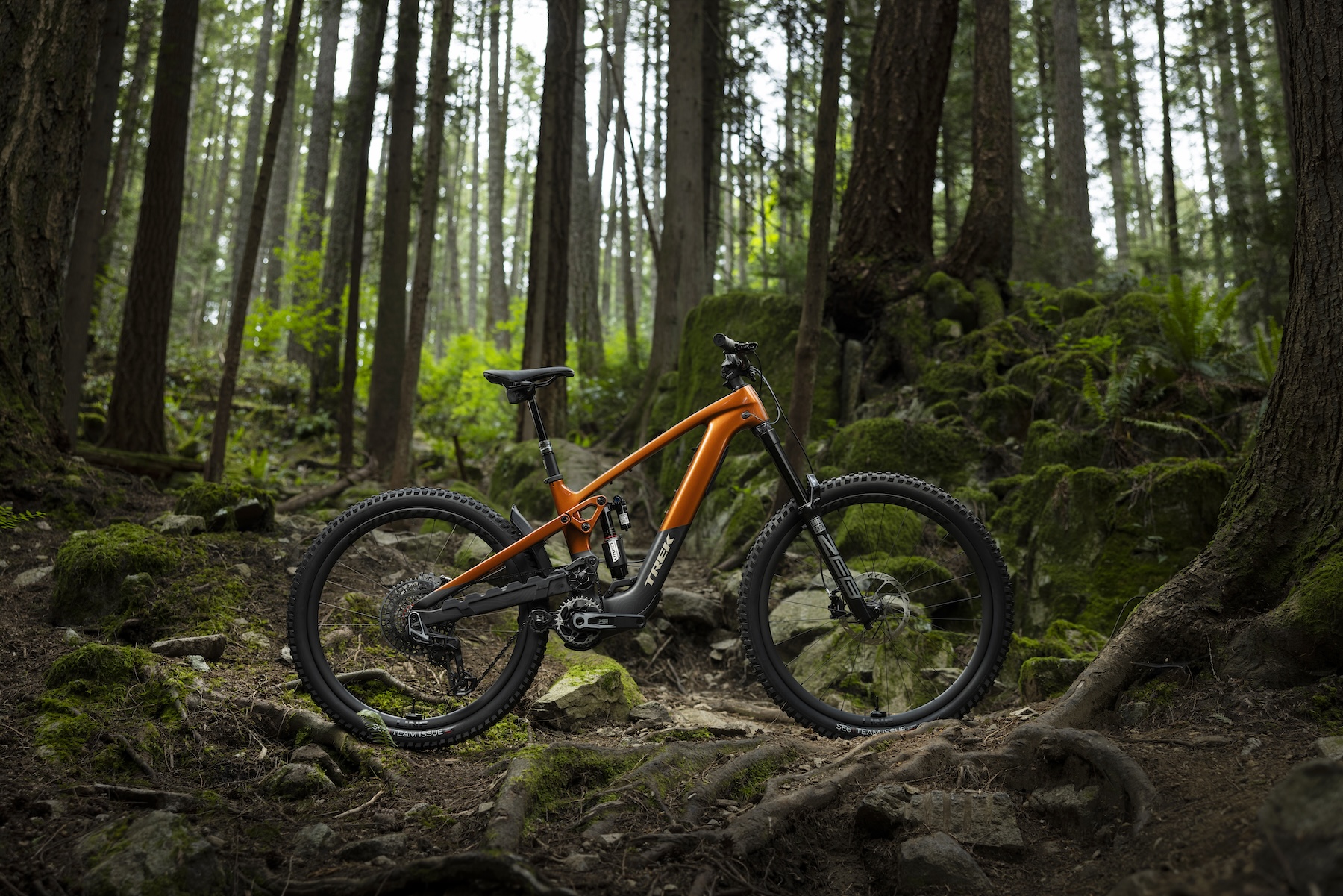
The Frame
The Slash+ is set up with 170 mm of travel front and rear, the rear being driven by Trek’s high pivot design adapted from the latest non-electric Slash. Trek’s high pivot layout relies on both an upper and lower idler, the upper being an oversized 19T pulley for quieter and more efficient performance, while the lower guide ensures good chain wrap on the front chainring while also integrating a bash plate.
The Slash+ frame is wholly constructed of Trek’s OLCV carbon fiber, but unlike the non-electric Slash, it can’t accept a 29’’ rear wheel — this is an all mullet, all the time affair. The size small Slash+ downsizes to 27.5’’ wheels all around, with Trek also moving the charging port to under the top tube to ensure that the full size 580 Wh battery can still fit on the smallest frame size while still having room for a water bottle (or range extender).
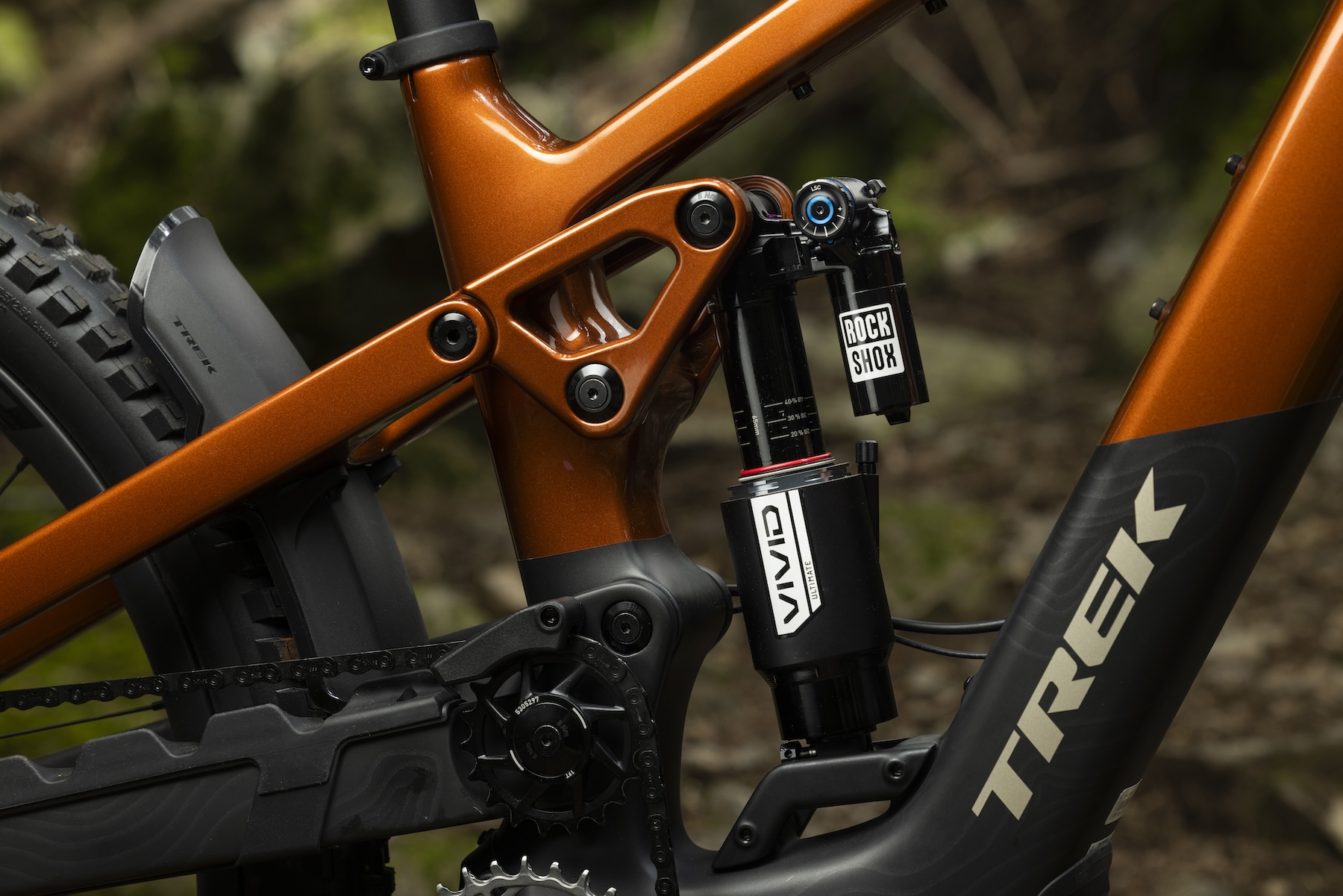
The high pivot rear suspension of the Slash+ is kinematically identical to that of the regular Slash, with the high pivot layout giving Trek the ability to design a very consistent level of anti-squat that remains just over 100% throughout the travel. The Slash+ also gets a progressivity adjustment via a small flip chip at the lower shock mount. Trek says that the chip comes in the less progressive setting from stock given the air shocks used on both builds, but the higher progression option will be particularly well suited to riders needing more support or who elect to run a coil shock.
Drive System
While we’ve often seen lightweight eMTBs going the route of packing less travel, the Slash+ takes an interesting route by going with a lightweight TQ HPR50 motor and large (for a lightweight eMTB) 580 Wh battery. This was not a given from the start during Trek’s development process, but rather the product of ride testing of multiple options to find the magic mix for what they were looking to create.
The TQ HPR50 motor has been seen on Trek’s Fuel EXe, but it’s a notably compact and quiet drive unit packing 50 Nm of torque, 250 W of continuous power, and 300 W peak power. That’s not a leading amount of torque compared to some other options in the world of lightweight motors, like the Bosch SX (55 Nm of torque, 600 W power) and Fazua Ride 60 (60 Nm of torque, 450 W power), but TQ emphasizes having a particularly natural-feeling assist.
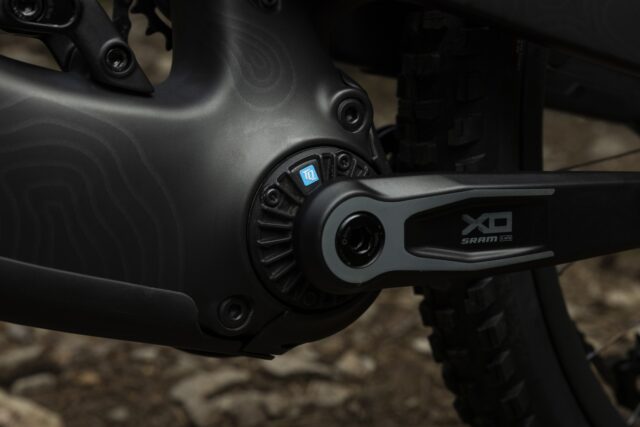
Norco recently released a few high pivot-equipped eMTBs as well in their VLT lineup, but the Slash+ joins a rather small group of electrified high pivot bikes. Packaging a motor and battery into a high pivot layout poses some hidden challenges, and Trek had the task of working with TQ to tweak the motor to function properly with the addition of the upper idler pulley. Trek also asked TQ to develop a larger battery capacity than the 360 Wh battery on the Fuel EXe to accommodate the likely use case of the Slash+, which was envisioned as including some big climbs to get to big descents. TQ over-delivered in that area, creating a new 580 Wh battery that is compact enough to fit even in the size Small frame. That battery is also compatible with their 160 Wh range extender for the truly range-anxious rider.
Other details of the TQ integration are the same as the Fuel EXe. Fitment wise, the battery is bolted into the frame, but can be easily removed by undoing those two bolts, removing the downtube protector, and sliding it out from just ahead of the motor. Trek was careful to design the Slash+ without a cable nest ahead of the motor to prevent battery swap headaches. The same top tube display provides all relevant data while the bar-mounted controller allows for mode switching, with customization options provided by the Trek Central app.
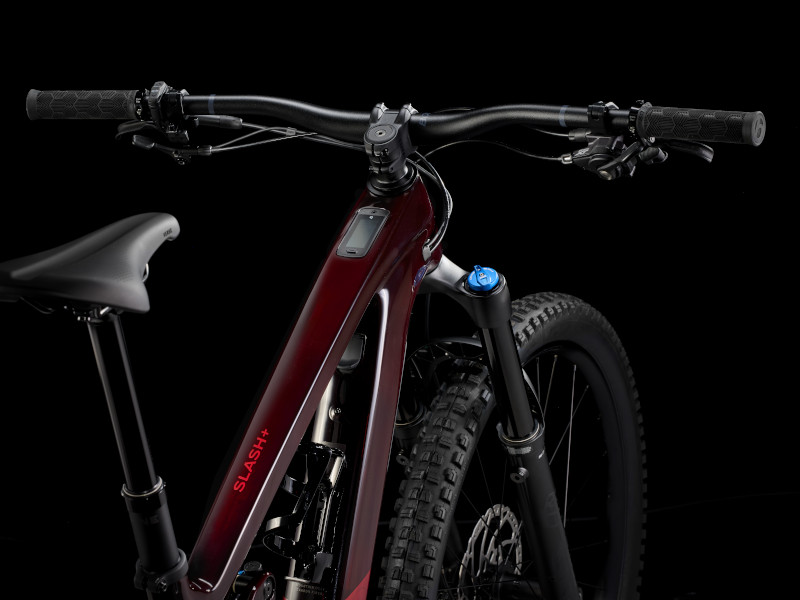
Fit & Geometry
Trek was unapologetically content with the geometry of the human-powered Slash, so aside from doing away with the M/L frame size option and adjusting reaches on the Medium and Large to fill that gap, other metrics are almost identical. Using the Large as a reference point, the Slash+ gets a 479 mm reach, a 640 mm stack, 434 mm chainstays (same for S and M sizes — 439 mm with the XL), and stock 63.4° headtube angle. The effective seat tube angle fluctuates slightly across sizes, but is suitably steep at 77.2° on the Large.
Adjustable headset cups allow for 0.5° of headtube angle adjustment in either direction away from the stock Neutral setting. Moving to the Slack or Steep position does have some cascading effects on other geometry figures, but beyond elongating or shortening the wheelbase by approximately 10 mm over the Neutral setting, those impacts are fairly minimal with respect to other measurements.
Full geometry figures are as follows:
The Builds
Trek is offering just two build options for the Slash+, with both sharing the same OCLV carbon frame and 580 Wh battery, and carrying fairly hefty price tags.
At $7,999.99 USD / $10,999.99 CAD, the lower spec Slash+ 9.7 build is a Fox and Shimano affair, with a 38 Rhythm fork and Float X rear shock paired with a blended Shimano XT / SLX drivetrain. The $11,999.99 USD / $15,999.99 CAD Slash+ 9.9 is a full SRAM build with X0 Transmission and Ultimate-level suspension, plus it gets carbon Bontrager Line Pro wheels where the lower spec 9.7 gets Line Comp aluminum wheels.
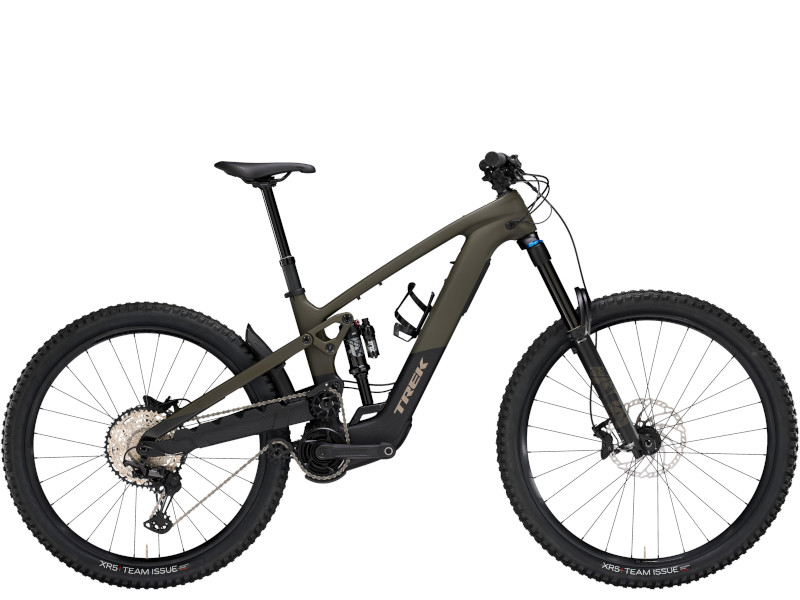
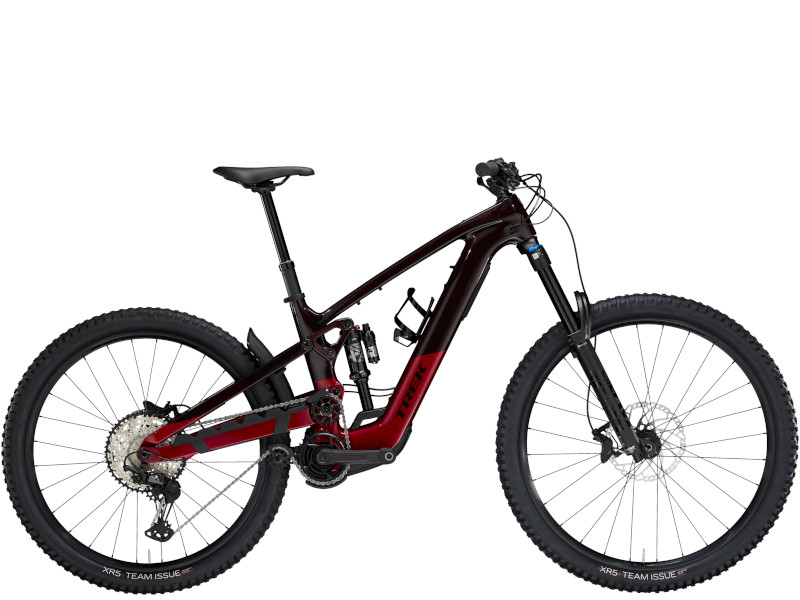
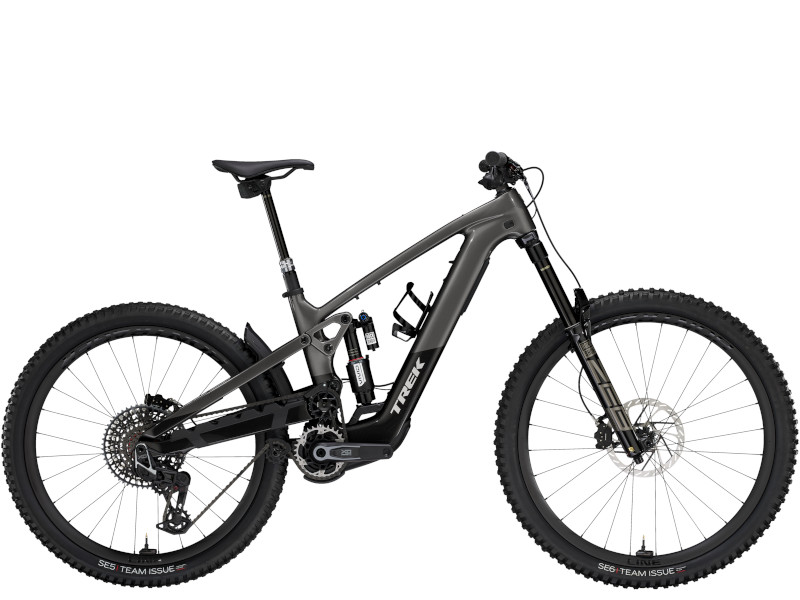
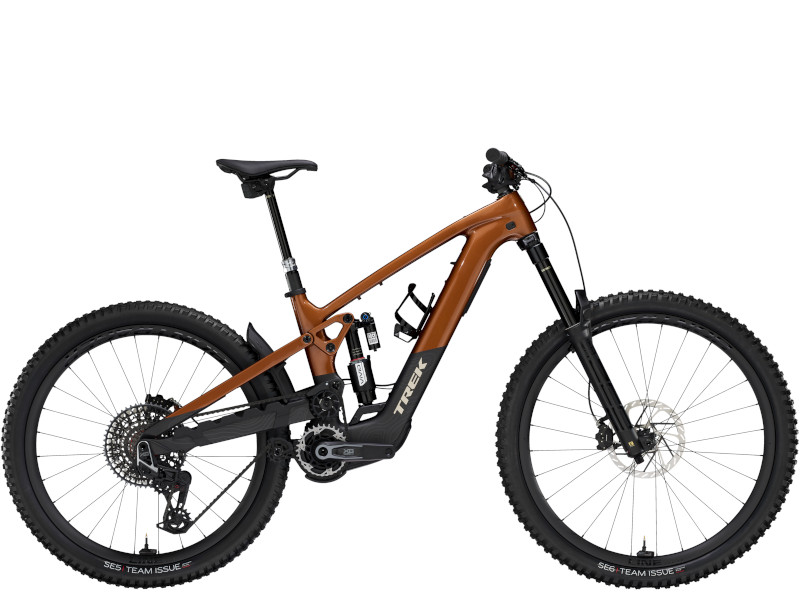
Both bikes see quite a few Bontrager parts, with the Slash+ 9.9 getting higher end parts in nearly every instance, including tires. The Slash+ 9.7 has slightly less aggressive XR5 Team Issue tires, whereas the Slash+ 9.9 gets Bontrager’s updated SE6 and SE5 Team Issue tires. While we’ve had some less than ideal experiences with Bontrager’s prior SE tires in wet conditions, the new Team Issue tires have a much softer compound borrowed from the brand’s Downhill tires, which should go a long way toward resolving our complaints.
Despite the higher-end parts on the Slash+ 9.9, it come with a higher claimed weight at 46.04 lbs / 20.88 kg. The lower end Slash+ 9.7 is a claimed 44.94 lbs / 20.38 kg.
Build highlights are as follows:
- Drivetrain: Shimano XT / SLX
- Brakes: Shimano Deore M6120 (203 mm rotors)
- Fork: Fox 38 Rhythm (170 mm)
- Shock: Fox Float X Performance
- Wheels: Bontrager Line Comp 30 MX
- Dropper Post: Bontrager Line MaxFlow (170 mm)
- Drivetrain: SRAM X0 Transmission
- Brakes: SRAM Maven Silver (200 mm rotors)
- Fork: RockShox ZEB Ultimate (170 mm)
- Shock: RockShox Vivid Ultimate
- Wheels: Bontrager Line Pro 30 MX
- Dropper Post: RockShox Reverb AXS (170 mm)
FULL REVIEW
The Trek Slash+ surprised us a bit at launch by going with the burly, 170 mm travel high pivot layout of the regular Slash, but merging it with the lightweight TQ HPR50 drive unit. We were particularly impressed with the suspension performance of the fully human-powered Slash when we tested it, but how would the stable and planted feel afforded by Trek’s high-pivot design mesh with the relatively lightweight but not super powerful TQ motor?
A few months with the Slash+ told a more nuanced story than we expected.
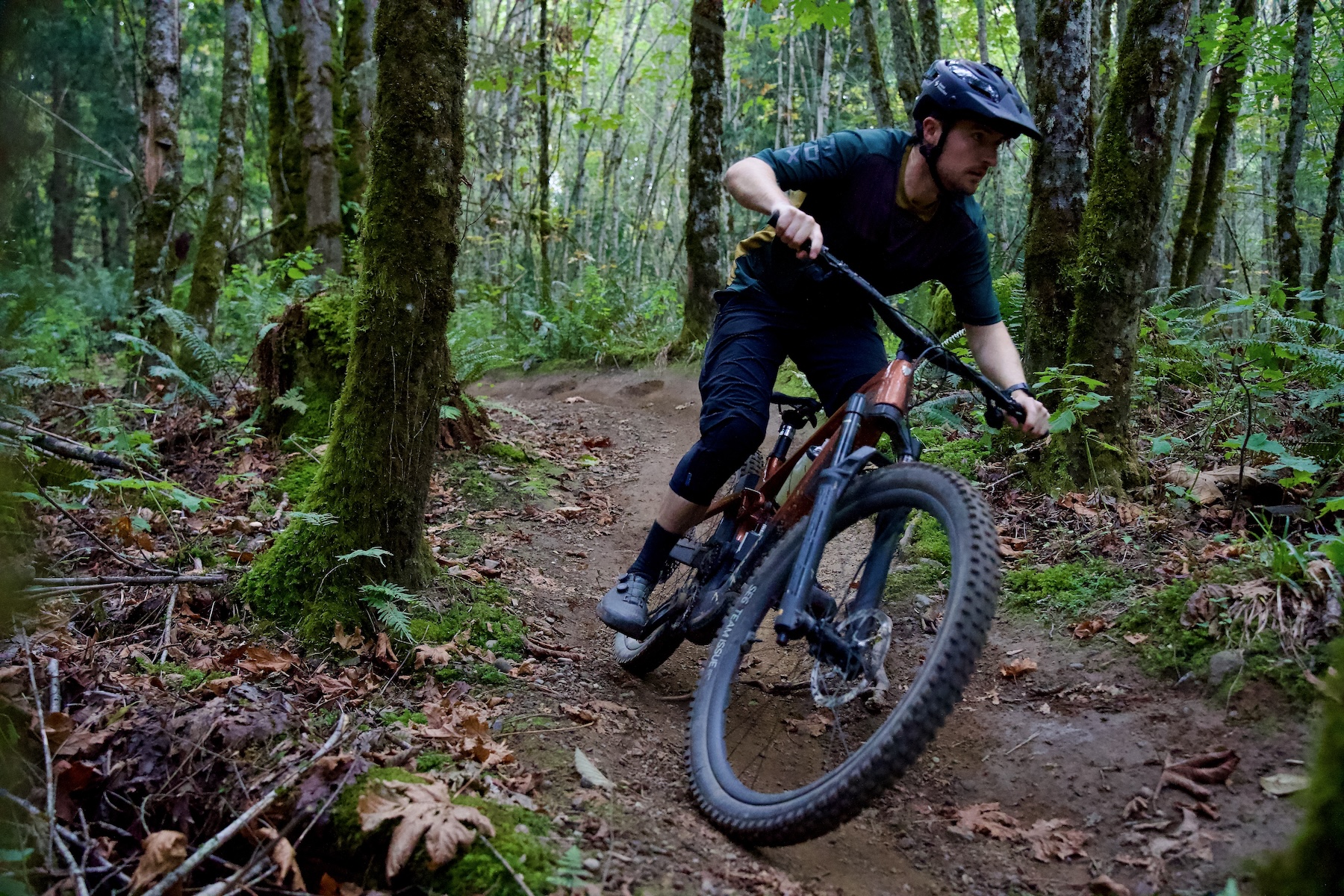
Fit & Sizing
At 6’0 / 183 cm, I am right in the middle of Trek’s recommended sizing range for the size Large Slash+, and while I did wish for a tiny bit more front-center length, it was generally a very good fit. Its 479 mm reach measurement is quite close to my typical preference. Though its 639 mm stack is just a tiny bit shorter than what I would prefer on a big Enduro-focused bike, the Bontrager Line Pro handlebar felt shorter than the advertised 27.5 mm rise (possibly due to the bar’s flat-ish 4° upsweep), leading me to add more spacers under the short 35 mm stem. By doing so, I reduced both the reach and effective top tube measurements slightly, and swapping to a 40 mm stem and higher-rise bar gave me my preferred handling while also giving me a bit more space in the cockpit.
The question of sizing up or down on the Slash+ never crossed my mind, largely because the steps between sizes are quite significant. The XL gets a very long 470 mm seat tube, 669 mm effective top tube length, and 519 mm reach — it’s a massively bigger bike than the Large in just about every measure, but should make truly tall riders happy in its dimensions.
[It’s worth noting that those sizing breaks are a bit different from the standard Slash, despite the two bikes’ similarities elsewhere. The Slash+ isn’t offered in the intermediate M/L size that can be had on the Slash, so the Medium and Large Slash+ sizes got tweaked to fill the gap more evenly.]
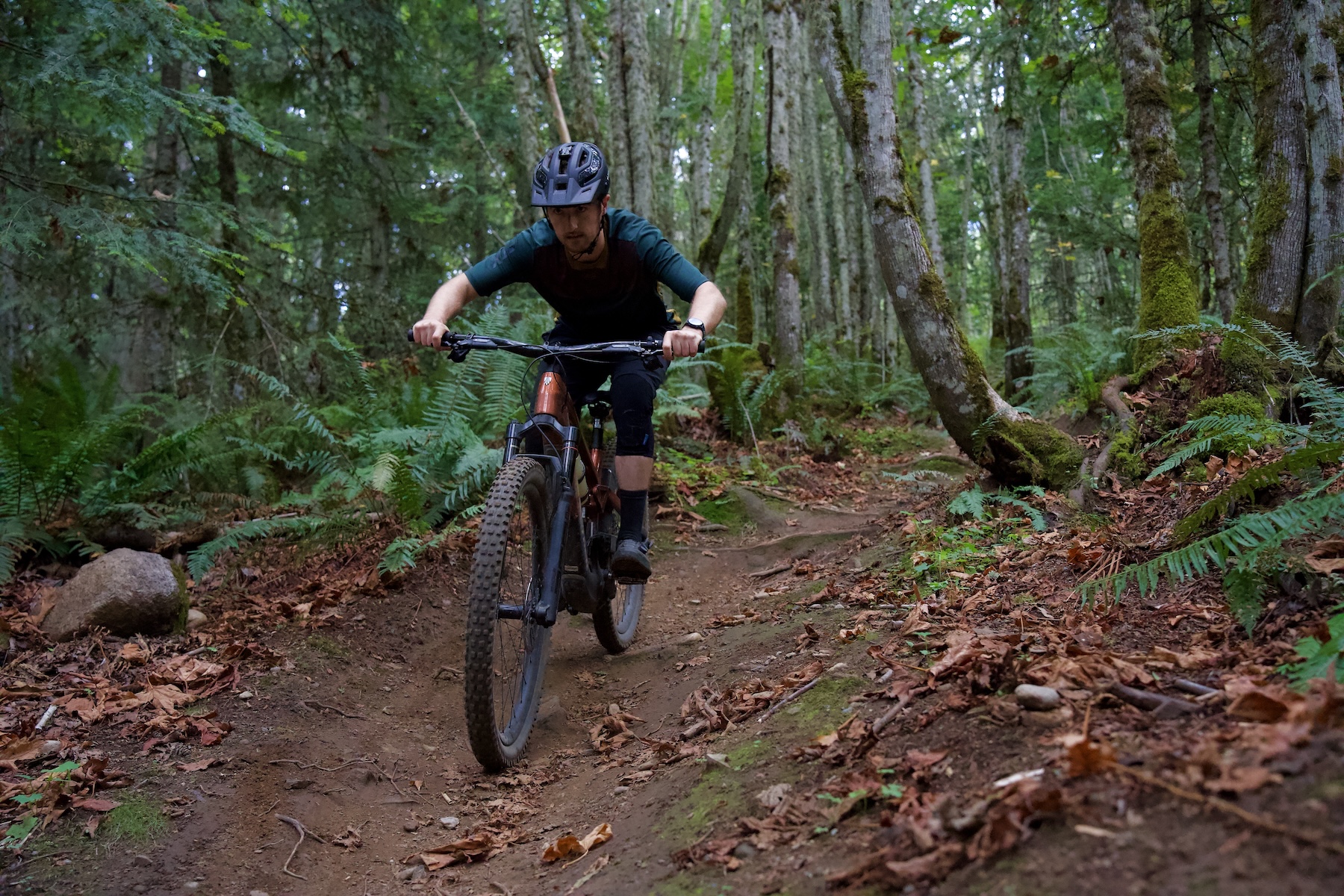
The Slash+’s seat tube angle is perhaps the one measurement I might change, given the choice. The effective seat tube angle sits at 77.2°, but that’s based on a somewhat slack 73.9° actual angle, meaning that running the saddle higher than the reference height can start to put your weight farther rearward than the effective seat tube angle might imply. For a bike like the Slash+, which is more likely to spend time slogging up steep climbs to access long descents, I think a 1–2° steeper seat tube angle would better suit its intentions.
Climbing
Of course, just about any eMTB is going to feel like a rocketship on the way up the hill, but there’s perhaps more nuance to the Slash+ and its performance while climbing.
As mentioned above in the Fit section, I might prefer a steeper seat tube angle on particularly brutal climbs, though even just bumping to a 40 mm stem (from 35 mm stock) helped to bring a bit more weight over the front wheel and reduce some wheel flop — which is unsurprising, given the stock configuration of a rather slack 63.4° headtube angle matched to a stubby 35 mm stem.
From a suspension perspective, the Slash+’s high-pivot layout does a good job of controlling excess suspension motion while offering good compliance and traction on slippery surfaces. The dual pulleys required for the high-pivot suspension layout do generate a good bit of noise, especially in drier conditions when I had perhaps gone too long without cleaning and re-lubing the drivetrain, and I’m betting that two pulleys sap a few more watts than just one — though that matters far less when a motor is involved.
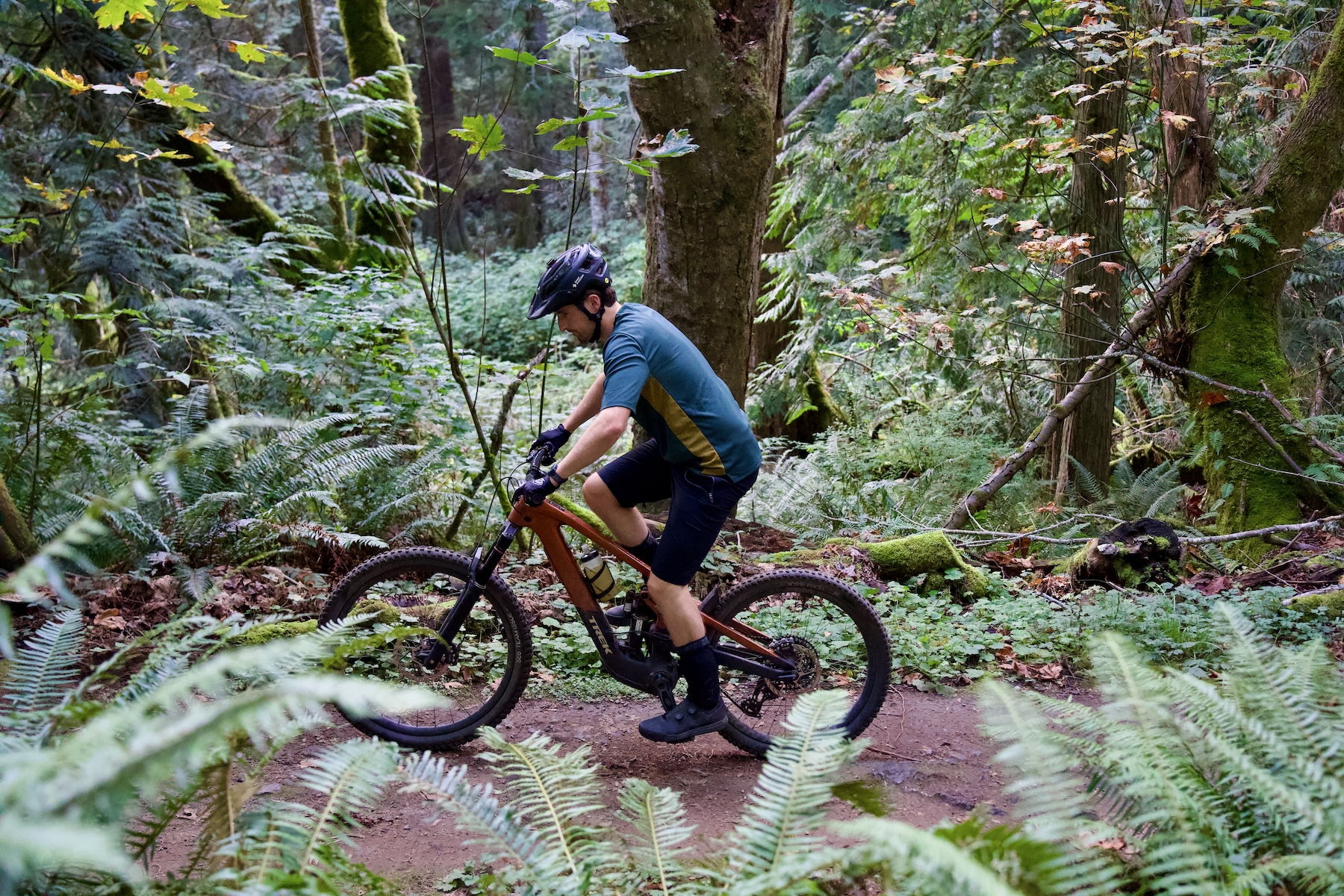
That brings us to the elephant in the room — as a light-assist eMTB, the Slash+ and its TQ HPR50 motor bring a slightly different climbing experience compared to a bigger full-power motor. The TQ HPR50 unit maxes out at 50 Nm of torque and 250 W of peak power, which is a whole lot less than the 85 Nm of torque and 600 W of power afforded by a full-power Shimano EP801 or Bosch Performance Line CX motor. As mentioned in our First Look above, the TQ HPR50 is also a good bit less powerful than even the lightweight motors from Shimano, Bosch, and Fazua.
Those on-paper differences are noticeable on the trail. The TQ motor demands quite a bit more rider input than other motor systems, even in the most powerful of the TQ HPR50’s three modes. There are, of course, multiple pros and cons here. On one hand, the TQ motor runs quietly, with the multiple pulleys of the Slash+’s high-pivot design often contributing more noise than the motor. This combo also feels almost eerily natural in its assist, relative to a full-power bike. The TQ HPR50’s power delivery comes on more gently than a punchy full-power motor and more closely matches the rider’s effort in technical climbing situations requiring a bit more finesse. On rides where I was riding the Slash+ but wanted to push harder for a better workout, the TQ motor felt like a great blend of still letting me cover ground fairly quickly, but making me work for it.
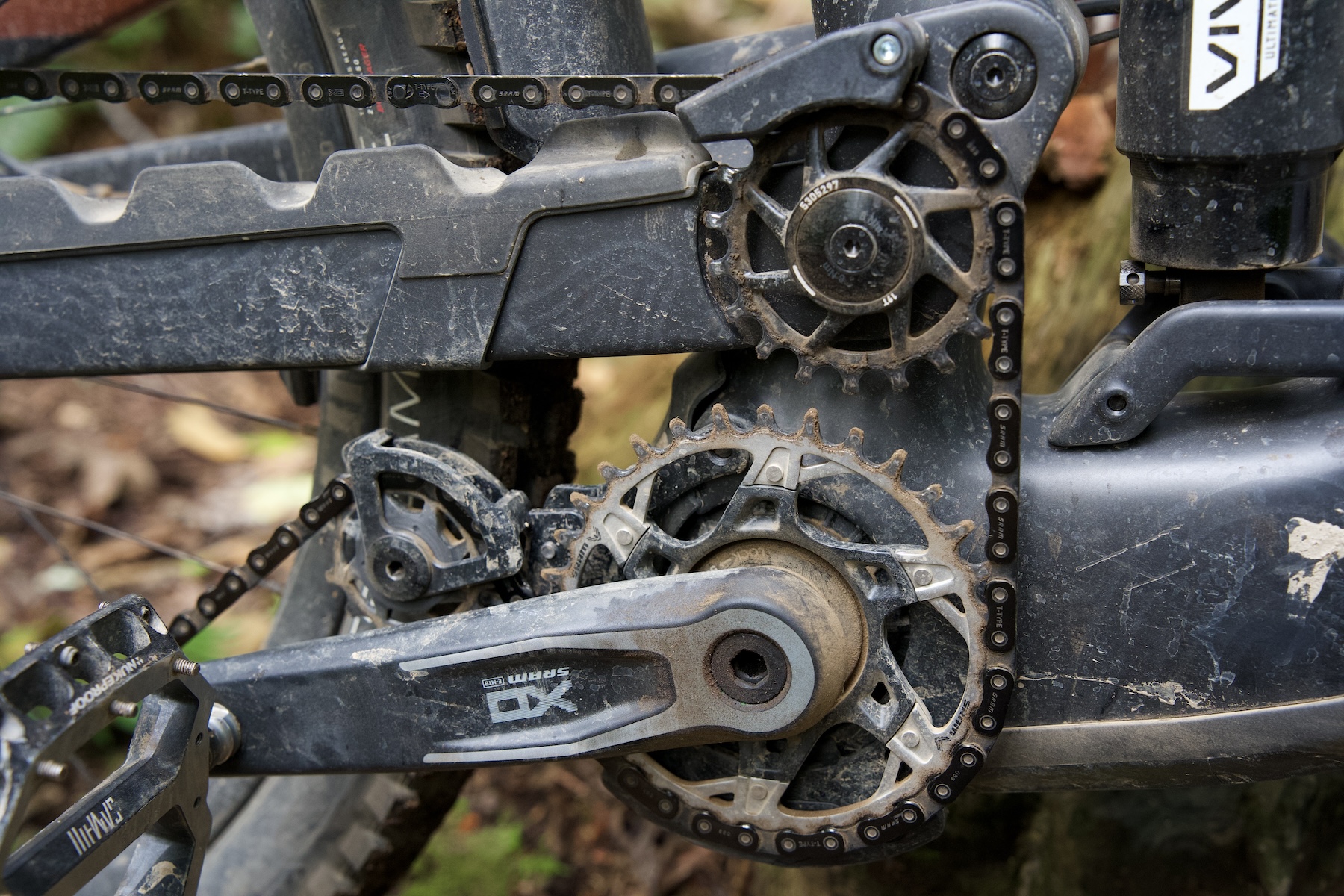
On the other hand, the TQ motor gets absolutely smoked by full-power bikes in terms of output potential — it simply doesn’t have the torque or power to keep up. On more gradual climbs, it’s a bit less of a dramatic difference, but on particularly steep climbs, the TQ HPR50 starts to bog down pretty sharply, demanding a high cadence to keep the motor pushing out power. While I could often keep up with full-power bikes on less demanding inclines by working a bit harder, it was no contest as things got steeper — even in the TQ’s most powerful output setting. That does mean that riding the Slash+ with folks on non-motorized bikes might be more feasible, though it still handily outpaces an unassisted bike unless the rider is quite fit.
Descending
Folks following the Downhill World Cups may have noticed certain teams strapping lead weights to their bikes’ bottom brackets to increase the sprung weight and add stability to their race bikes. In a similar way, anyone who has spent time on a full-power eMTB has likely noticed some of the effect that the added weight has in muting larger impacts and generating a more sensitive suspension feel. However, a full-size motor and battery add far more weight than is ideal, leading to some sluggish handling and often struggling for grip while braking heavily.
When Trek talked us through the development story of the Slash+, they made it clear that the lightweight TQ motor platform was chosen over a full-power system because it allowed Trek to create a more natural-feeling package in the Slash+, one that prioritized descending performance. Given our experience with the non-electric Trek Slash, we expected a forgiving and stable ride from the Slash+. Still, we were curious whether the addition of a motor and battery make it feel like a big, heavy eMTB, or would the lightweight drive system contribute a more unique ride character? For the right rider, there’s a lot to like about the Slash+ as the trail turns downward.
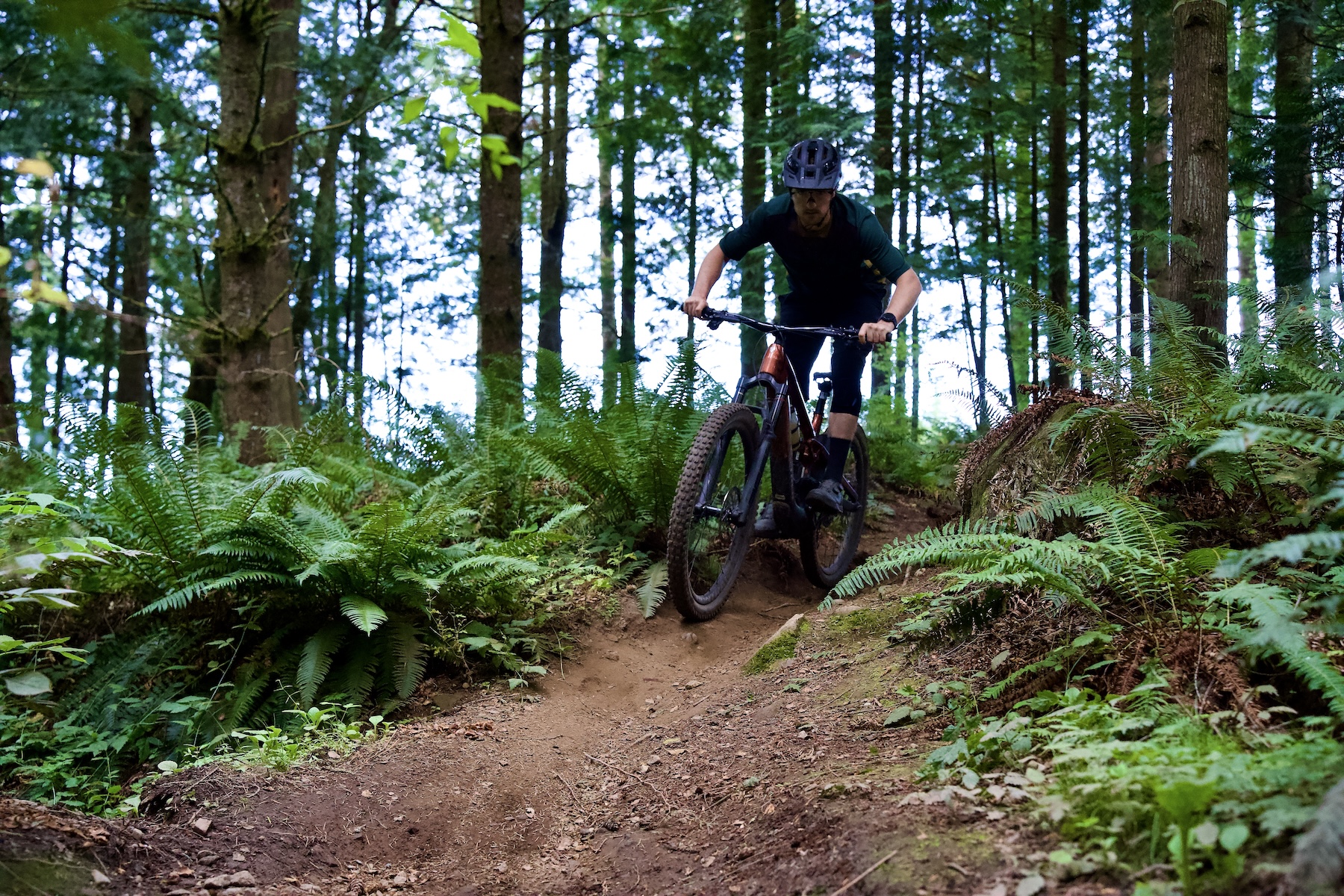
The rear suspension feel of the Slash+ is excellent. Paired with the high-volume RockShox Vivid Air shock, the suspension feels predictable and supportive through the travel, with plenty of sensitivity without feeling vague or mushy when pushing the bike into holes or well-supported corners. I was impressed by how easy it was to get the Zeb fork and Vivid Air shock working in concert, but the rear suspension was always the star of the show. Regardless of whether the trail was fast and rough or slow and steep, it had an ability to track the ground and seemingly use just enough travel on any given compression, allowing the bike to recover quickly and keep trucking as that added heft from the battery and motor held onto momentum.
The Slash+’s high-pivot design uses a “high-ish” main pivot, still resulting in a largely rearward axle path, but one that is a bit more conservative compared to something like the Forbidden Dreadnought. The Slash+’s rear suspension keeps that trademark high-pivot feeling of allowing the wheel to move away from obstacles, but it never feels like the rear end is lengthening so much as to disrupt the balance point while cornering. It’s a relatively neutral-feeling rear suspension without any particular quirks, but it does sit a bit more on the planted side of the spectrum, rewarding faster riding by muting sharp impacts impressively well.
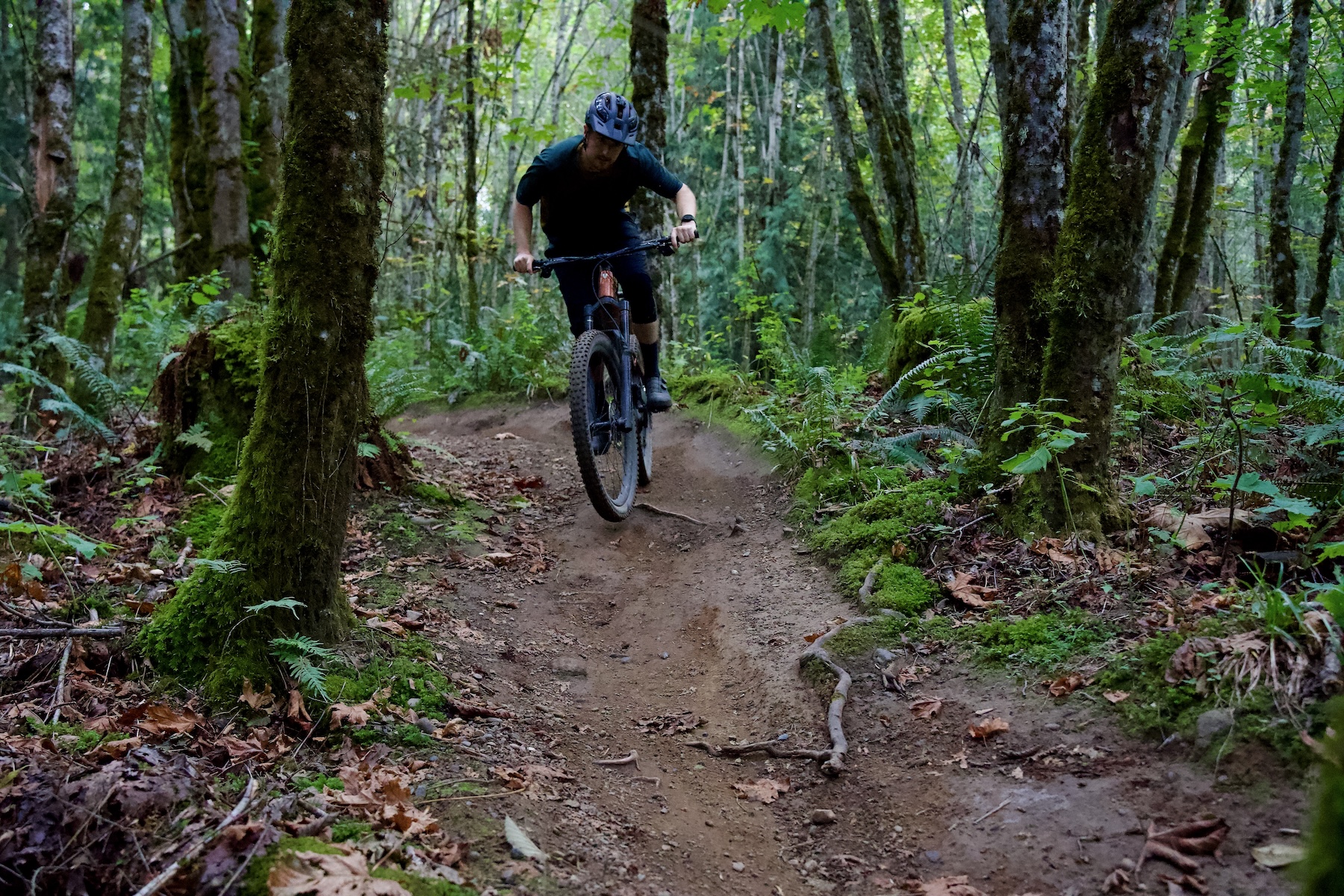
The Slash+ doesn’t have the 29’’ rear wheel option of the regular Slash, but the mixed-wheel configuration feels well suited to the Slash+’s otherwise more stable demeanor. Its smaller 27.5’’ rear wheel feels a bit more out of the way on super steep terrain while also being a bit more “loose” and easier to place into ruts. The slightly lower gyroscopic force also helps to bring a bit of playfulness into what is otherwise a fairly slack, game-on bike — I didn’t miss a 29’’ rear wheel option here.
While eMTBs often feel very composed over rough ground due to their added heft, there is often a significant tradeoff in steeper terrain where a 50+ lb bike can become difficult to manage. In my experience, this commonly manifests as a tendency to understeer, with the combination of a big motor and heavy battery often overwhelming the front tire in looser dirt. At 45.8 lbs / 20.8 kg, the Slash+ is still a heavy bike, but it’s also not as beefy as typical full-power bikes — for reference, my Transition Repeater has a rather chonky build and weighs 50.2 lbs / 22.8 kg.
While it still feels like a weighty bike in its composure over rough ground, the Slash+ feels both easier to tip into steep turns and easier to keep on-line under particularly heavy braking. In that regard, the Slash+ feels like something between a regular bike and full power eMTB — and it’s ultimately a more intuitive descender as a result.
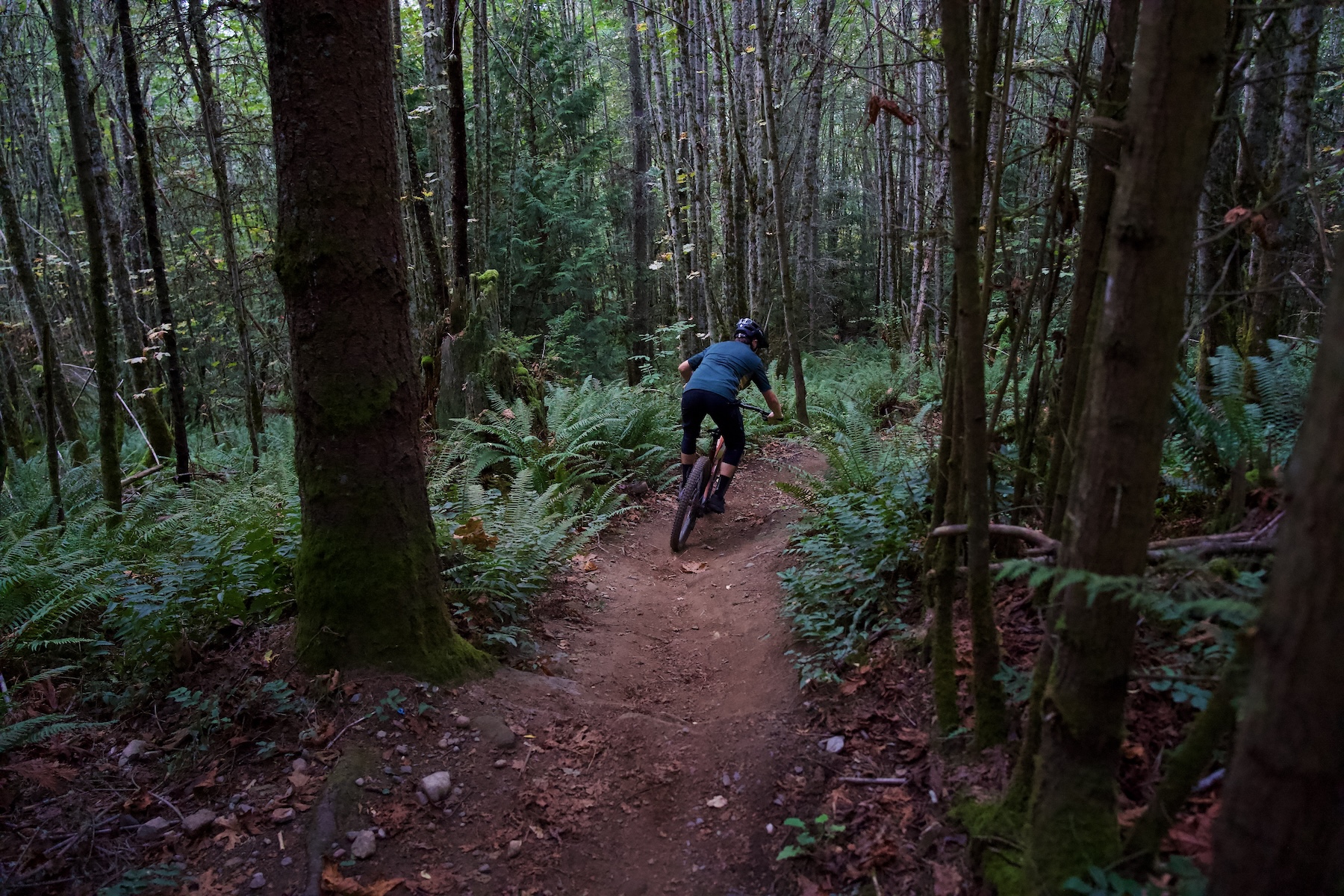
While the handling of the Slash+ was quite calm and collected, the racket coming from its chain over medium and large hits was distractingly loud. A hard plastic rear fender protects the pivots from mud and debris, but it also runs right next to the chain as it exits the upper chain guide, which is also made of a hard plastic. The chain rattled around that area quite loudly, and while applying the soft side of some velcro tape to the fender and inside of the upper chain guide helped a bit, there was still a decent bit of noise while rumbling down the trail. The complexity of the chain path made it a bit difficult to pinpoint exactly which areas were causing all the noise, but I think there’s more work to be done by Trek in improving noise isolation.
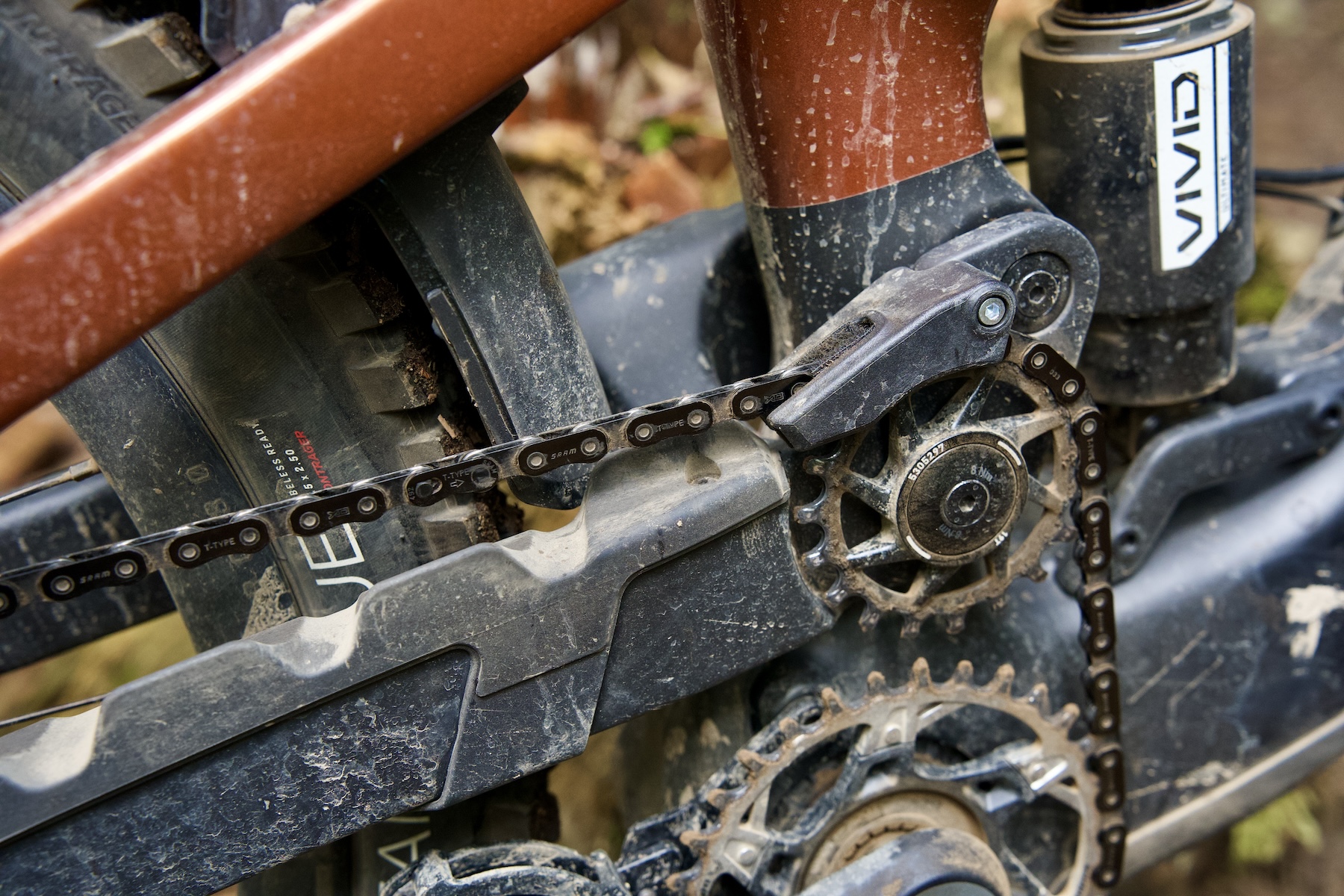
Drive System and Range
The TQ HPR50 motor isn’t as popular as mid-power offerings from Shimano, Bosch or even Fazua, but we see good reason for that to change. Simply put, the TQ HPR50 motor is likely the quietest motor I’ve ridden while also managing to be the most natural-feeling in the way it delivers power. Even in the highest power mode (of the three on offer), there was never a “jolt” as the system engaged as there can be with some other (often more powerful) systems, and the TQ motor’s ability to sense and match the rider’s output helped to make technical climbs feel much more intuitive. All in all, the smooth and quiet operation of the TQ system helped the motor assist fade into the background over the course of our time with the Slash+.
I’ve already talked at length about the compromises inherent in opting for a lower-power motor (see the Climbing section), so I won’t dwell on that here. It is worth mentioning that, perhaps relating to its lower power output, I struggled to detect all that much of a difference in output between the Slash+’s three assist modes. There is a small difference, particularly between the lowest level of assist and the highest, but it’s much, much more subtle than toggling between Eco, Trail and Boost modes on a Shimano EP8, for example. Though, if I’m honest, I tended to leave the Slash+ in the highest output mode until I started getting nervous about battery life.
On the battery front, I was incredibly grateful for the capacity offered by the 580 Wh battery. Anything smaller would likely have been frustratingly small, especially on a bike like the Slash+ which seems best suited to seeking long, technical descents that so often require long climbs to get there. While the battery seemed to last roughly as long as the 630 Wh battery on my personal EP8-equipped bike, I was typically running the Slash+ in the highest-output motor setting, whereas I spend more time in Trail and Eco modes on full-power bikes. The range estimation offered via the TQ display fluctuates often based on motor setting and steepness of the terrain, but still proved useful as the battery started running low. I did find that battery life tended to fall much more quickly once the display read 30% or lower, but I’ve experienced that with some other bikes as well.
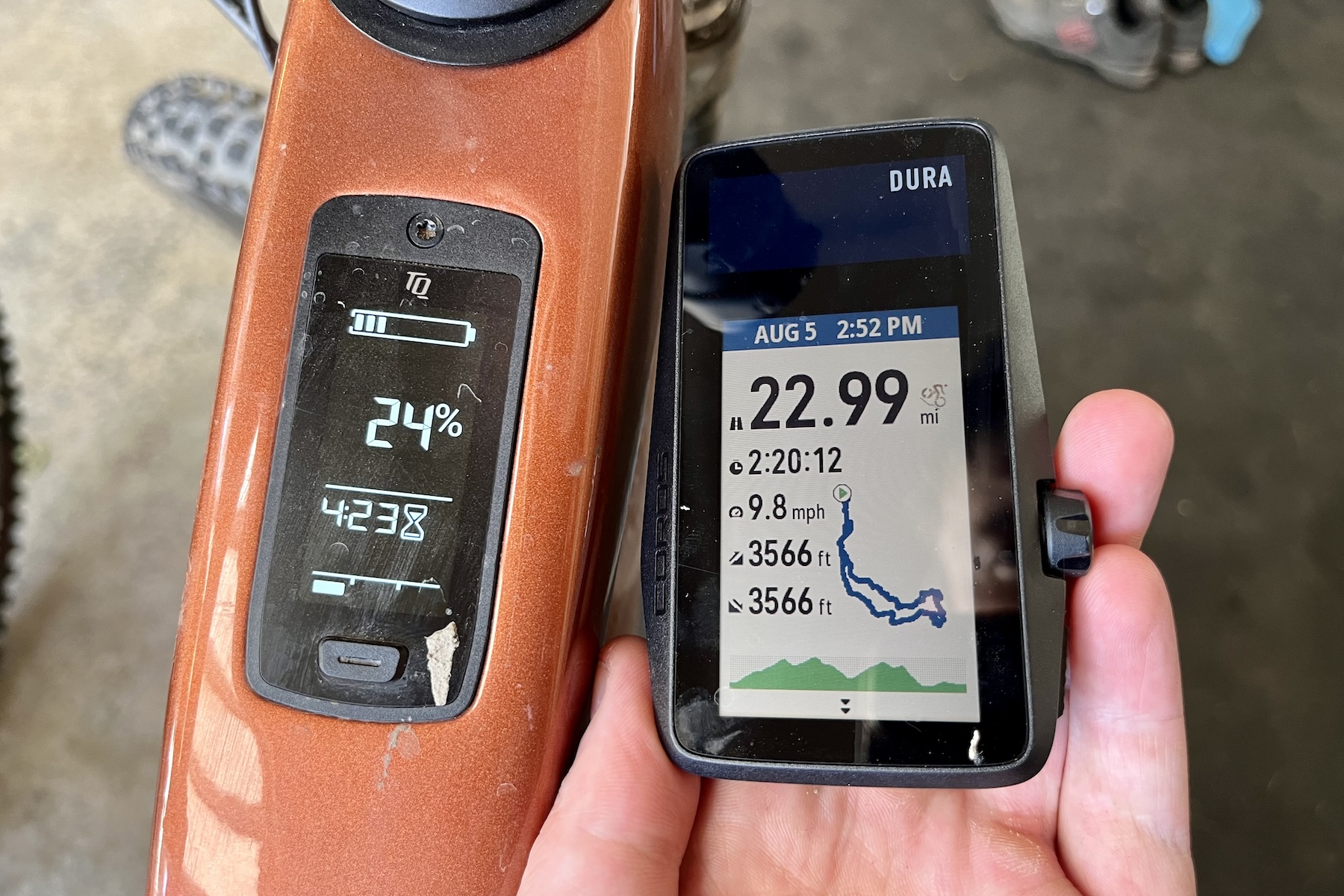
I managed to kill the battery once on a longer ride, somewhat earlier than expected. This happened on a ride with some particularly steep fire road climbs, and I got the sense that the TQ motor was running fairly inefficiently as it struggled to deliver the power and torque needed in such steep terrain. Though the range extender add-on would mitigate anxiety around the range, this again suggests taking a hard look at the type of terrain you typically ride. Even in this worst case, the battery shuts off before fully drained to allow the hardwired SRAM Transmission derailleur to keep working, which I was rather grateful for as I finished my pedal to the trailhead.
On a final note, I’m a fan of the simple top tube display. It offers all of the metrics that I cared for, and the system as a whole didn’t miss a beat during testing. Configuration of the motor profile can be done in the well-executed Trek app, though we left the stock settings intact for our testing.
The Build
Our Slash+ 9.9 test bike retails for $11,999 USD, so you’d expect that the build kit would be stellar. For the most part, it leaves little to be desired, though it’s hard to make any sort of argument that it’s a particularly great value.
The Ultimate-level suspension from RockShox (Zeb fork + Vivid Air shock) performs very well, with the Vivid Air shock pairing notably well with the Slash+’s suspension design. The SRAM Maven Silver brakes are brutally powerful, and while the initial lever feel is a bit stiff for my liking, I was never wanting for power, even when skidding down steep tracks on this 45+ lb eMTB. The Bontrager Line Pro carbon wheels held up well, despite several rim contacts with sharp rocks, and though the freehub is a bit noisy for my tastes, it does offer high engagement.
The Bontrager tires are an improvement over their prior iterations, but they still are not quite up to par with the best in the Enduro category. Starting from the front, the Bontrager SE6 tire adopts the 2-3-2 pattern popularized by tires like the Maxxis Assegai, with this updated Team Issue version of the SE6 getting Core Strength sidewalls and a new softer rubber compound. It’s a rather high-volume tire, and I found the casing to be a bit less supportive than I would have liked, resulting in a vague feeling under high cornering loads. Grip was fairly good, though the rubber compound did struggle in wet conditions, particularly on harder surfaces like rocks, woodwork, and roots.
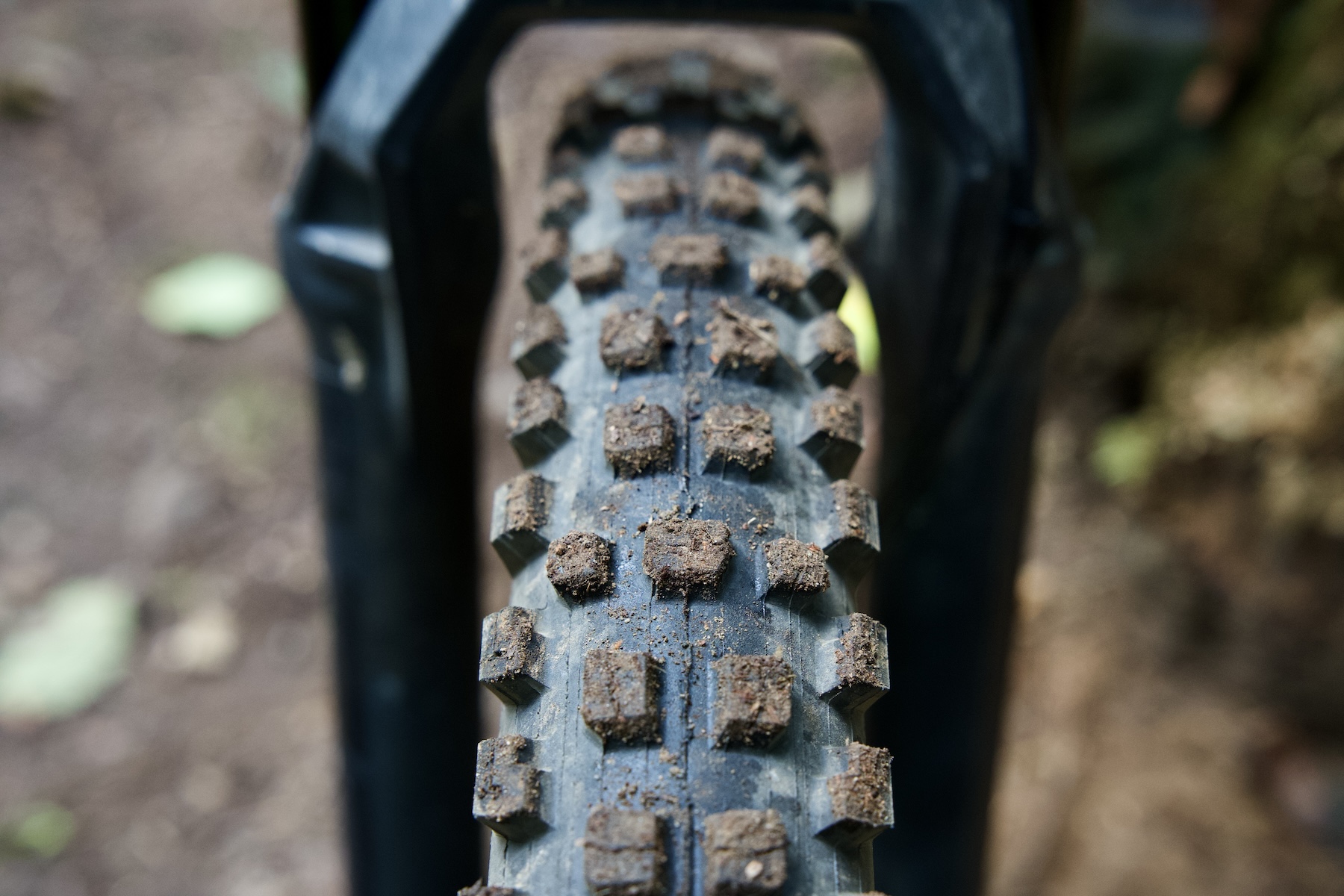
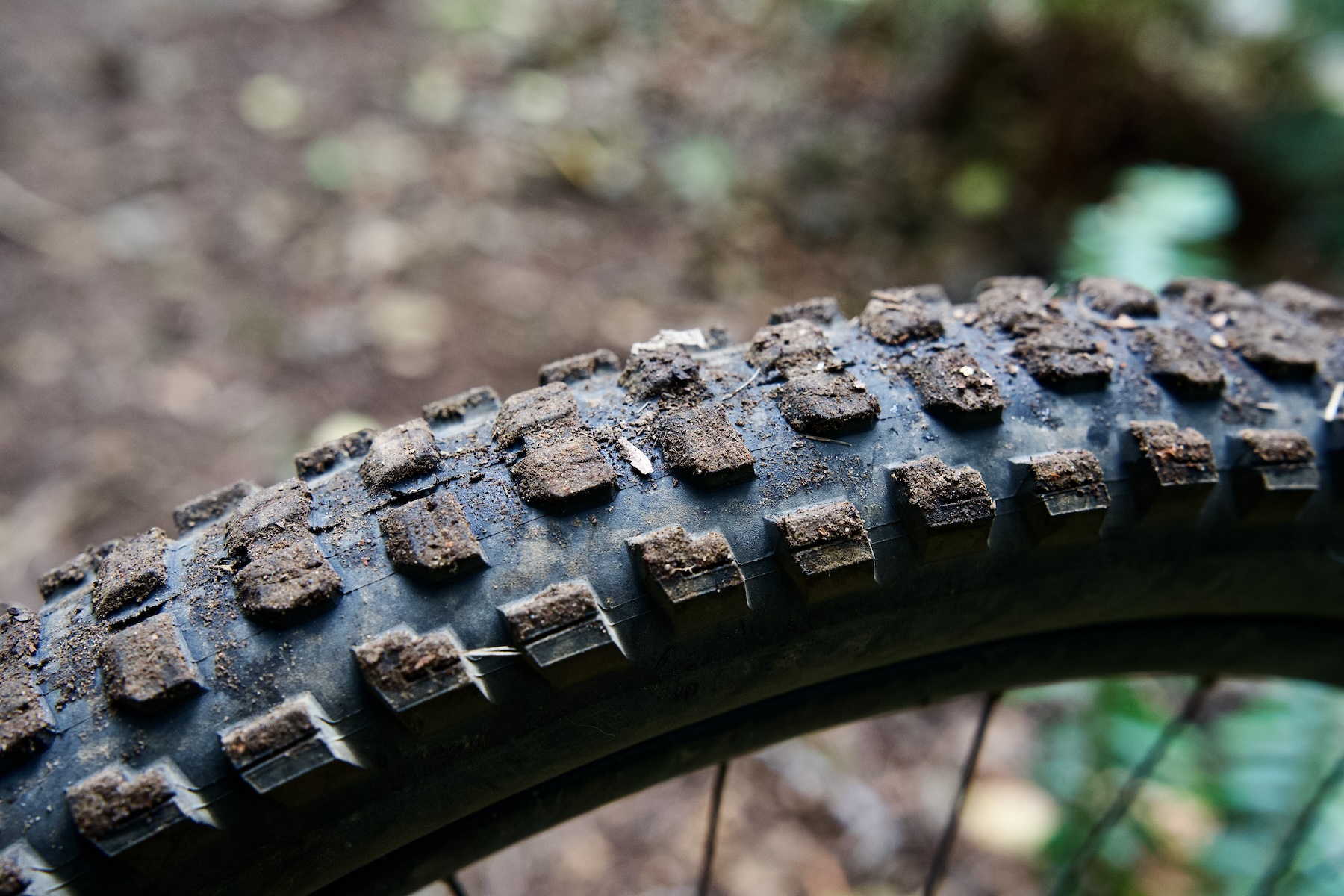
The Bontrager SE5 Team Issue rear tire was the lowlight of the pairing, offering lackluster grip on damp or dusty surfaces and struggling to dig into looser dirt due to its short and broad knobs and rather high-volume profile. It does seem to roll fairly quickly, no doubt aided by the broad-yet-short knobs, but that’s low on my list of priorities for an eMTB. A toothier tire would dig into the terrain a bit more to keep the power down in softer conditions — and the motor helps any added drag feel well worth the tradeoff for more traction.
As someone who has recently been enjoying the freedoms of a packless riding experience, I appreciated the inclusion of the Bontrager BITS tool in the steerer tube. The magnet that secures it in place is almost too strong, making it a bit hard to remove, but the tool functioned well despite its tiny size. Longer and more remote rides would of course warrant a chain tool, tire plugs, pump/CO2, etc., and I still carried my trusty OneUp pump in those cases. But for local hot laps, the BITS setup was a nice inclusion.
There are a few personal-preference-related swaps that I would make to the build as well. I mentioned earlier that I had some different cockpit preferences relative to the stock Bontrager setup, with the Line Pro handlebar having a bit more backsweep than I prefer (9°) and the 35 mm stem being a bit shorter than I like. The Reverb AXS dropper tops out at 170 mm of drop, and I’d definitely prefer at least 200 mm on a bike like the Slash+.
While the 9.9 build is dripping in top-shelf parts, dropping down to the Slash+ 9.7 cuts a whopping $4,000 USD / $5,000 CAD from the sticker price. While the Fox 38 Rhythm fork and Float X Performance shock leave a bit to be desired on the suspension front, you could get just about any suspension setup under the sun with your cost savings. And, while there’s no carbon wheelset or electronic shifting, the aluminum Bontrager Line Comp wheels, 4-piston Shimano Deore brakes, and Deore/SLX drivetrain present a great performance-to-price ratio.
Who’s It For?
As someone who has the luxury of riding 5+ days a week on both my unassisted bike and an eMTB, I personally find the full-power bike to be more fun for covering steep climbs at a blistering pace and plummeting back down. When I want a workout or a more dynamic ride feel, I can simply go back to my regular ride. An eMTB will always be a second bike for me, and a full-power one in particular would never be my only bike.
Of course, some folks are short on time due to a wide variety of factors, and for those folks, a lightweight eMTB like the Slash+ may start to sound quite appealing. It can cover more ground than a regular bike while still offering a pretty good workout matched with more familiar handling on the way down, relative to a full-power eMTB. Shoppers who are looking for a particularly stable and forgiving ride but don’t want the more sluggish downhill handling of a full-power setup are likely ideal candidates for the Slash+. Despite being a big, purposeful bike, it still manages to feel significantly easier to maneuver in steeper terrain compared to a full-power eMTB. It’s truly excellent as a descender, regardless of the fact that it has a motor, and riders with terrain that warrants a burly 170 mm high-pivot bike will likely be quite pleased in that respect.
As appealing as all that is, the tradeoff in motor power by going with the TQ HPR50 system on the Slash+ is significant, especially for folks who live in places with particularly steep climbs where the motor can be more easily overwhelmed. Keeping up with your buddies on full-power bikes will be a tall order on the Slash+ on the way up the hill, but if more intuitive and forgiving handling on the way back down the hill is your priority, that tradeoff may be well worth it.
Bottom Line
The Trek Slash+ is an interesting offering that doesn’t have all that many close peers. On one hand, it offers very forgiving and plush-feeling high-pivot suspension and feels like a big, descending-oriented bike in that respect. On the other hand, its lightweight TQ motor helps to cut weight compared to a full-power system, providing more familiar handling traits for folks who are used to (or prefer) fully human-powered bikes — with the tradeoff being significantly less power and torque on steeper climbs.
Even compared to non-electric bikes, the Slash+ is a standout descender and delivers a much less cumbersome feel than a full-power eMTB while still offering some assistance on the way back up. As long as you are willing to accept less oomph from the drive unit, there aren’t many other bikes that offer that balance of traits.




Great review, with some interesting observations.
I’ve got a lot of time on the Fuel EX-e, and have found the Level 3 power setting to be more than I ever wanted. Luckily, it’s very easy to retune with the Trek app. But my e-bike quest is for a regular feeling steed that lets me ride longer without draining myself, so perhaps a different approach than most full-powered riders.
The only other worthwhile comment I have is that I really, really hope Trek uses this new, bigger battery approach to fit something a bit larger than the current 360 battery on the “next” Fuel EX-e. I’ve found range to a bit lacking, despite typically using lower power settings than many.
Thanks Tom —glad you enjoyed the review. That Fuel EXe that you have was one of the early examples of a mid-power eMTB, and the growing set of eMTBs in this category indicates that there are a whole lot of other folks like you that are looking for a bit of assistance without ending up on a ~50 pound behemoth. While the sheer speed and torque on tap with a full power motor is novel and fun, a mid-power eMTB is easier to live with day-to-day for most people.
No promises, but it sounds like the Trek team had been working hard with TQ for a while to develop the new, larger battery option. Given that work is now done, it wouldn’t surprise me one bit to see it as an option going forward.
Yeah, good review. You brushed on something I’ve noticed about the TQ system- it’s less efficient in boost/turbo modes, or when cadence/rider wattage drops. This can be a pro or a con, depending on what you’re looking for. I have used an enduro’d EXe as my primary bike, and I found having to keep it in Eco/trail modes with the cadence up, got me acceptable range and also kept my fitness up to “meat bike” levels. So this can be a “pro” if you want to use it as a primary bike. But yeah, riders who want the occasional boost-life fix will want a full-power.